May 27-June 5 UConn Physics Department hosted an international summer school Strong interactions beyond simple factorization: collectivity at high energy from initial to final state. The school was supported by an NSF grant to Prof. Kovner and was devoted to modern approaches to the physics of high energy hadronic and heavy ion collisions.
Research
Posts related to the research mission of the Physics Department
Amelia Henkel, Graduating President of the Undergraduate Women in Physics Club, speaks about her time at UConn

Amelia Henkel, graduating Double Major in Physics and Human Rights, and President of the Undergraduate Women in Physics Club, speaks on the CLAS website about her passion for physics and human rights, and how she mastered challenges in her remarkably interdisciplinary curriculum. “We really need to interact with other disciplines,” says Amelia, “because that’s when physics has the opportunity to make a real impact on the rest of the world.” Her broad research interests range from A to W: from Astronomy to Women’s, Gender, and Sexuality Studies. “Respecting and promoting human rights is a prerequisite to realizing our full potential as human beings,” says Amelia. Physics as a discipline has made progress to become more inclusive, but many groups remain minorities including women. In daily college life in physics departments female students still face “microaggressions and discriminatory practices” which are often unintended and unconscious but nonetheless damaging and frustrating. As the President of the Undergraduate Women in Physics Club, Amelia helped to organize “events that promote community cohesion and inform the students about the nature of some of the barriers that exist in physics and in STEM, while talking about how we can overcome them.” The recent department-wide event Women in Physics Colloquium organized by Amelia was thought provoking and well-received. The percentage of women earning a Bacheleor’s Degree in Physics from UConn, though slowly increasing and compatible with the national average of about 20% published by APS, is far away from where we wish to be. But the efforts of students like Amelia contribute to improving the situation. Many thanks to Amelia whose commitment helps to make our department better.
Read more about Amelia on the CLAS website. A short summary of her story is in UConn Today.
2019 Pollack Lecture
On April 11th and 12 of 2019 Prof. Paul Corkum of the Joint Attosecond Laboratory (University of Ottawa and the National Research Council of Canada) visited the department. Prof. Corkum’s main area of research is on the interaction of ultrashort laser pulses with matter broadly defined. His most notable contribution is perhaps the discovery of the so-called three-step model, which has become the basis of the emerging field of attosecond science. Attoseconds, equal to 1 billionth of 1 billionth of a second (10-18 s) is the shortest time scale ever measured or controlled by humans and is at the forefront of modern optics.
Prof. Corkum is a member of the US National Academy of Sciences, the Russian Academy of Sciences, the Austrian Academy of Sciences, the Royal Canadian Academy of Sciences and the Royal Society of London. He has received many accolades throughout his career, including the Thomson Reuters Citation Laureate which is awarded to researchers who are “of Nobel class” and likely to earn the Nobel someday and the Order of Canada.
On April 12, Prof. Corkum presented the annual Edward Pollack Distinguished Lecture, entitled “Attosecond Pulses Generated in Gases and Solids”. This lecture is supported by an endowment established by the family of the late Professor Edward Pollack in 2005. Ed’s family, friends and colleagues made contributions in his memory. This special colloquium provides a presentation in Ed’s honor in the field of atomic, molecular and optical physics, his area of research expertise. This year Mrs. Rita Pollack and their three children: Cindy [U.S. Government civil servant], Lois [now a professor of applied physics at Cornell], and Howard [professor of modern languages (German) at dePauw University in Indiana] were all in attendance.
Below, dinner with the Pollack family members, UConn faculty, and guests.
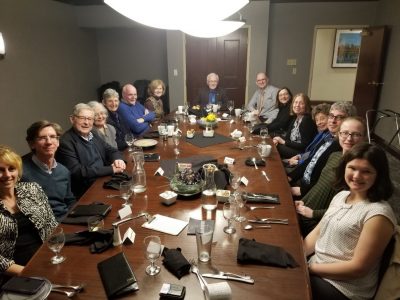
Astronomers Assemble View of Evolving Universe
– Donna Weaver & Ray Villard, Space Telescope Science Institute
The University of Connecticut’s Katherine Whitaker is part of a team of astronomers who have put together the largest and most comprehensive “history book” of the universe from 16 years’ worth of observations from NASA’s Hubble Space Telescope.
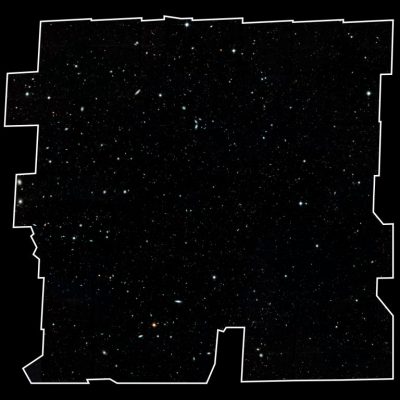
The deep-sky mosaic provides a wide portrait of the distant universe, containing 200,000 galaxies that stretch back through 13.3 billion years of time to just 500 million years after the Big Bang. The tiny, faint, most distant galaxies in the image are similar to the seedling villages from which today’s great galaxy star-cities grew. The faintest and farthest galaxies are just one ten billionth the brightness of what the human eye can see.
The image yields a huge catalog of distant galaxies. “Such exquisite high-resolution measurements of the legacy field catalog of galaxies enable a wide swath of extragalactic study,” says Whitaker, the catalog lead researcher. “Often, these kinds of surveys have yielded unanticipated discoveries that have had the greatest impact on our understanding of galaxy evolution.”
The ambitious endeavor, called the Hubble Legacy Field, also combines observations taken by several Hubble deep-field surveys, including the eXtreme Deep Field (XDF), the deepest view of the universe. The wavelength range stretches from ultraviolet to near-infrared light, capturing all the features of galaxy ‘assembly over time.
“Now that we have gone wider than in previous surveys, we are harvesting many more distant galaxies in the largest such dataset ever produced,” says Garth Illingworth of the University of California, Santa Cruz, and leader of the team. “This one image contains the full history of the growth of galaxies in the universe, from their times as infants to when they grew into fully-fledged ‘adults.’”
Illingworth says he anticipates that the survey will lead to an even more coherent and in-depth understanding of the universe’s evolution in the coming years.
The deep-sky mosaic provides a wide portrait of the distant universe, containing 200,000 galaxies that stretch back through 13.3 billion years of time to just 500 million years after the Big Bang.
Galaxies trace the expansion of the universe, offering clues to the underlying physics of the cosmos, showing when the chemical elements originated and enabled the conditions that eventually led to the appearance of our solar system and life.
This new wider view contains 100 times as many galaxies as in the previous deep fields. The new portrait, a mosaic of multiple snapshots, covers almost the width of the full Moon, and chronicles the universe’s evolutionary history in one sweeping view. The portrait shows how galaxies change over time, building themselves up to become the giant galaxies seen in the nearby universe. The broad wavelength range covered in the legacy image also shows how galaxy stellar populations look different depending on the color of light.
The legacy field also uncovers a zoo of unusual objects. Many of them are the remnants of galactic “train wrecks,” a time in the early universe when small, young galaxies collided and merged with other galaxies.
Assembling all of the observations was an immense task. The image comprises the collective work of 31 Hubble programs by different teams of astronomers. Hubble has spent more time on this tiny area than on any other region of the sky, totaling more than 250 days.
The image, along with the individual exposures that make up the new view, is available to the worldwide astronomical community through the Mikulski Archive for Space Telescopes (MAST), an online database of astronomical data from Hubble and other NASA missions.
The new set of Hubble images, created from nearly 7,500 individual exposures, is the first in a series of Hubble Legacy Field images. The team is working on a second set of images, totaling more than 5,200 Hubble exposures, in another area of the sky.
In addition, NASA’s upcoming James Webb Space Telescope will allow astronomers to push much deeper into the legacy field to reveal how the infant galaxies actually grew. Webb’s infrared coverage will go beyond the limits of Hubble and Spitzer to help astronomers identify the first galaxies in the universe.
The Hubble Legacy Fields program, supported through AR-13252 and AR-15027, is based on observations made with the NASA/ESA Hubble Space Telescope, obtained at the Space Telescope Science Institute, which is operated by the Association of Universities for Research in Astronomy Inc., under NASA contract NAS 5-26555.
This article first appeared in UConn Today on May 2, 2019.
UConn Physics Professor elected to AAAS
UConn physics professor Nora Berrah has been elected to the historic and prestigious American Academy of Arts and Sciences. This year, more than 200 individuals were elected to the academy with compelling achievements in academia, business, government, and public affairs. Berrah, who was head of the physics department from 2014 to 2018, has been recognized for her distinguished contributions to the field of molecular dynamics, particularly for pioneering non-linear science using X-ray lasers, and spectroscopy using synchrotron light sources.
Using big lasers – like the Linac Coherent Light Source at SLAC National Laboratory on the campus of Stanford University, the most powerful X-ray laser in the world – Berrah’s research explores transformational changes occurring inside molecules when exposed to ultra-intense beams of light. In particular, she investigates physical molecular processes that occur at the femtosecond time scale: one quadrillionth, or one millionth of one billionth, of a second.
“The American Academy for Arts and Science honors excellence and convenes leaders to examine new ideas, and that it is a high honor bestowed on me,” Berrah said.
The 2019 class includes poet and Andrew W. Mellon Foundation president Elizabeth Alexander; chemical and biological engineer Kristi S. Anseth; artist Mark Bradford; gender theorist Judith Butler; economist Xiaohong Chen; academic leader and former Governor Mitchell E. Daniels Jr.; neuro-oncologist Robert B. Darnell; The Atlantic journalist James M. Fallows; author Jonathan Franzen; cell biologist Jennifer Lippincott-Schwartz; data science and McKinsey & Company technology expert James Manyika; former First Lady Michelle Obama; Cisco Systems business leader Charles H. Robbins; mathematician Sylvia Serfaty; philosopher Tommie Shelby; actress and playwright Anna Deavere Smith; and paleoclimatologist Lonnie G. Thompson.
This post has been transcribed from the announcement on UConn Today.
UConn Astronomers React to First Photo of a Black Hole
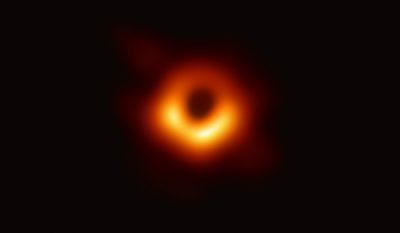
This image is the first ever taken of a black hole, captured by the Event Horizon Telescope (EHT) project. The black center is a direct view of the event horizon of a supermassive black hole with a mass of 6.5 billion times the Sun, lying at the center of the Virgo cluster of galaxies. The bright ring is emission from hot gas just above the event horizon, with an asymmetric shape caused by gravitational lensing of light in the strong gravity of the black hole. The EHT collaboration captured the image using a network of 8 radio telescopes that spanned the Earth, effectively creating a planet-sized interferometer.
This result directly impacts research in galaxy evolution and cosmology that is being carried out at UConn. The following comments from UConn Astrophysics researchers indicate the level of interest that this result has generated within the international Astrophysics community.
This is a stunning technical achievement. Supermassive black holes are the most extreme objects in the Universe, bizarre rips in spacetime that lie in the center of every massive galaxy. But despite their extreme properties, black holes have a remarkably simple mathematical description, with just a few numbers describing all of their vital properties: mass, size, and spin. Until now, the only way to measure black holes was through indirect methods, like my own research program that uses the timing of light echoes in the surrounding gas. The Event Horizon Telescope black hole image is a tremendous first step in a new understanding of extreme gravity and the detailed astrophysics of black holes. – Jonathan Trump, Assistant Professor
I am fascinated by this result and how we can actually see a direct image of a black hole that is a trillion times our distance to the Sun. This is truly an amazing result for human beings achieved within the limitation of our observational instruments. As an observational astronomer who works with black holes, this result also opens up new possibilities to learn about their unknown features such as black hole spin that could revolutionize our understanding of black hole physics. – Yasaman Homayouni, Graduate Student
This result is a beautiful demonstration of what is possible when the global community works in concert towards a scientific goal. Sometimes the greatest discoveries are not found by the biggest new telescopes in space, but through creative thinking, years of dedicated effort, and big data techniques, building upon what we have here on Earth. – Cara Battersby, Assistant Professor
It is truly extraordinary to be able to provide this new evidence for Einstein’s ideas on space and time through observations made no less than one hundred years since he first proposed them. As to the discovery itself, there are two aspects to black holes, one is that they pull everything in, and the other is that they do not let anything out. With nothing being able to get out, they thus look black to an observer on the outside, to thereby give them their black hole name. Now for many years we have had evidence of things falling into black holes, but had never previously had any evidence that things cannot get out. These new data show a fireball ring of things falling in, with the ring surrounding a black space in the center where nothing can get out. We thus confirm that indeed nothing can escape a black hole. – Philip Mannheim, Professor
For more about this topic, see this recent article in the Daily Campus, UConn Astronomy Community Responds Joyously to M87 Black Hole Image.
Charles Reynolds Lecture 2018: Prof Andrew Millis
The 2018 Reynolds lecture speaker was Prof Andrew Millis, a Professor of Physics at Columbia University and a co-Director of Center for Computational Quantum Physics at the Flatiron Institute. Dr. Millis’s research focus is theoretical condensed matter physics. He is the leading authority in theory of correlated materials, application of new theoretical ideas to actual experiments on novel materials including high temperature superconductors. His theory of ‘colossal’ magnetoresistance seen in manganites has been the key theoretical advance that enabled a complete understanding of these materials. Andrew has also been working on quasi one-dimensional conductors and heavy fermion compounds. The lecture, entitled “Meeting Dirac’s challenge: from quantum entanglement to materials theory” presented a broad-stroke account of developments in humankind’s capability of explaining and predicting materials properties through advanced computational approaches.
Dirac wrote 90 years ago: “The underlying physical laws necessary for the mathematical theory of a large part of physics and the whole of chemistry are thus completely known, and the difficulty is only that the exact application of these laws leads to equations much too complicated to be soluble. It therefore becomes desirable that approximate practical methods of applying quantum mechanics should be developed, which can lead to an explanation of the main features of complex atomic systems without too much computation.’’ Professor Millis described the development of the new computational tools to meet the challenge laid out by Dirac in our quest for effective predictive tools for quantum materials. Center for Computational Quantum Physics, The Flatiron Institute is superbly positioned to address this challenge. The lecture was held on March 15 2019 and was well attended with a large number of undergraduate and graduate students present.
Contributed by Alexander Balatsky, edited by Jason Hancock
2 for the price of 1: UConn researcher finds new mechanism making double ionization an efficient process
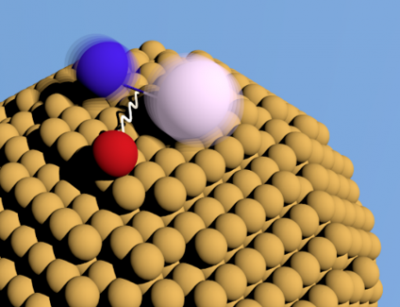
An international research team headed by Dr. Aaron LaForge from the research group of Prof. Nora Berrah in the Physics department at UConn has recently discovered a new type of decay mechanism leading to highly efficient double ionization in weakly-bound systems. The team has published its results in the science journal “Nature Physics”.
Ionization is a fundamental process where energetic photons or particles strip an electron from an atom or molecule. Normally, a much weaker process is double ionization, where two electrons are simultaneously emitted, since it requires higher-order interactions such as electron correlation. However, these new results show that double ionization doesn’t necessarily need to be a minor effect and can even be the primary ionization mechanism thereby getting two electrons for the price of one.
The enhancement is likely due to double ionization proceeding through a new type of energy transfer process termed double intermolecular Coulombic decay, or dICD, for short. The experiments were performed at the synchrotron, Elettra, in Trieste, Italy. There, electrons are accelerated to near the speed of light and then rapidly undulated through an alternating magnet field. In this way, the electrons emit short wavelength light which is needed to trigger dICD. The researchers produced superfluid helium droplets, which are cryogenic, nanometer-sized matrices capable of attaching various atomic and molecular species in order to perform precise spectroscopic measurements. In this case, dimers consisting of two alkali metal atoms were attached to the surface of helium droplets. The dICD process, schematically shown in Fig. 1, occurs through an electronically excited helium atom (red), produced by the synchrotron radiation, interacting with the neighboring alkali dimer (blue and white) resulting in energy transfer and double ionization. Although an alkali dimer attached to a helium nanodroplet is a model case, dICD is potentially relevant for any system where it is energetically allowed.
dICD belongs to a special class of decay mechanisms where energy is exchanged between neighboring atoms or molecules leading to enhanced ionization rates. Seemingly ubiquitous in weakly-bound, condensed phase systems such as van der Waals clusters or hydrogen-bonded networks like water, these processes can contribute to radiation damage of biological systems by producing particularly harmful low-energy electrons. dICD could strongly enhance such effects through the production of two low-energy electrons for each intermolecular decay.
Original publication:
A. C. LaForge, M. Shcherbinin, F. Stienkemeier, R. Richter, R. Moshammer, T. Pfeifer & M. Mudrich, “Highly efficient double ionization of mixed alkali dimers by intermolecular Coulombic decay”, Nature Physics (2019) DOI: 10.1038/s41567-018-0376-5
Kate Whitaker wins the Sloan Fellowship!
Original UConn Today article here
Rising Star in Astrophysics Receives Sloan Foundation Fellowship
As an assistant professor of astrophysics, Kate Whitaker spends a lot of her time thinking about stars. Hundreds of billions of stars that comprise galaxies, to be more precise. But with a recent fellowship from the Alfred P. Sloan Foundation, it is Whitaker’s star that is shining brightly.
Whitaker is one of 126 outstanding U.S. and Canadian researchers selected by the Alfred P. Sloan Foundation to receive 2019 Sloan Research Fellowships. The fellowships, awarded yearly since 1955, honor early-career scholars whose achievements mark them as among the most promising researchers in their fields.
Valued not only for their prestige, Sloan Research Fellowships are a highly flexible source of research support. Funds may be spent in any way a Fellow deems will best advance his or her work.
“Sloan Research Fellows are the best young scientists working today,” says Adam F. Falk, president of the Alfred P. Sloan Foundation. “Sloan Fellows stand out for their creativity, for their hard work, for the importance of the issues they tackle, and the energy and innovation with which they tackle them. To be a Sloan Fellow is to be in the vanguard of twenty-first century science.”
According to colleagues, Whitaker certainly fits the bill as one of the brightest young minds at UConn and beyond.
“Kate’s record so far is truly impressive and speaks to her potential as a leader in her field,” explains Barry Wells, head of UConn’s Department of Physics. “It was my great pleasure to nominate her for a Sloan Foundation Research Fellowship, and I am thrilled they felt she was worthy of the prize.”
An observational extragalactic astronomer, Whitaker’s research tries to reveal how galaxies are evolving from the earliest times to the present day.
In addition to her position at UConn, Whitaker is also an associate faculty at the new Cosmic Dawn Center in Copenhagen, Denmark. Whitaker and her students actively collaborate with DAWN, working towards pushing our detection of quiescent “red and dead” galaxies even earlier in time.
She will be among the world’s first scientists to explore the universe using the new James Webb Space Telescope when it is launched in 2019, which she says will allow her to push into new frontiers of research.
Apart from that exciting work, Whitaker and colleagues Cara Battersby and Jonathan Trump were tasked with building a full-fledged astronomy program from scratch at UConn. Not only has their work exceeded expectations, the fruits of their labor are already beginning to emerge. Whitaker and colleagues have so far created five new astrophysics courses with two more slated for next year, established an official astronomy minor, and are operating a thriving research program that involves doctoral students, undergrads, and even local high school students.
“I am both thrilled at this opportunity and humbled to be named amongst such a prestigious cohort of scientists,” says Whitaker. “With the Sloan Foundation’s generous support, I aspire to continue to lead ground-breaking studies of the distant universe, the mystery of which will no doubt captivate our imaginations.”
The Alfred P. Sloan Foundation is a philanthropic, not-for-profit grant making institution based in New York City. Established in 1934 by Alfred Pritchard Sloan Jr., then-President and Chief Executive Officer of the General Motors Corporation, the Foundation makes grants in support of original research and education in science, technology, engineering, mathematics, and economics. A full list of the 2019 Fellows is available at the Sloan Foundation website at https://sloan.org/fellowships/2019-Fellows.
Nora Berrah Named 2018 AAAS Fellow
Physics professor Nora Berrah has been named a 2018 Fellow of the American Association for the Advancement of Science (AAAS). Prof. Berrah has been recognized for her distinguished contributions to the field of molecular dynamics, particularly for pioneering non-linear science using x-ray lasers and spectroscopy using synchrotron light sources.
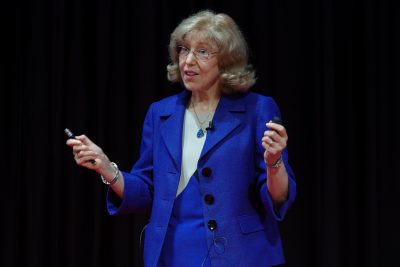
View full story on CLAS website.